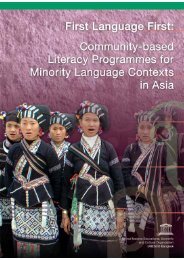Part II.pdf - MTB-MLE Network
Part II.pdf - MTB-MLE Network
Part II.pdf - MTB-MLE Network
You also want an ePaper? Increase the reach of your titles
YUMPU automatically turns print PDFs into web optimized ePapers that Google loves.
The target communities and their language situation<br />
After two field surveys among typical Lahu villages in 2002, researchers of RTCLE, language experts<br />
from the Education Bureau in Lancang County, and some skillful literacy facilitators in Lancang<br />
County agreed to select Nanuoke and Banli villages as the project target villages. Both of these<br />
two villages are composed of Lahu people.<br />
Nanuoke village is located in a semi-mountainous area, about 500-1,000 meters above sea level.<br />
The village has 76 households, with a total population of 304. Of those, 219 are labourers. The<br />
village comprises 1,298 acres of cultivated area. The average grain possessed by each individual<br />
is about 300 kilograms.<br />
Banli village is an administrative village under which there are ten natural villages, with<br />
303 households and a total population of 1,460. Most of the villagers are Lahu people, but some<br />
belong to other ethnic groups such as Wa and Hani.<br />
Both Nanuoke and Banli are located in remote mountain areas where transportation is inconvenient.<br />
The income of villagers mainly comes from planting tea, sugarcane and other farming work. Local<br />
illiterates and semi-illiterates are engaged in planting and breeding livestock. This is a form of<br />
self-sufficiency, and has not been integrated with trading.<br />
In daily life, the villagers speak their own language, and only when going to the hospital, going<br />
shopping or going to governmental agencies do they speak Chinese. Some young people can speak<br />
a little Chinese. Many villagers can also speak and write the Dai language. The Dai are another<br />
ethnic group located mainly in Xishuangbanna Prefecture, Yunnan Province.<br />
Based on the literature search, historical research and field surveys from the two villages, the research<br />
group found the following:<br />
Vicious circle of illiteracy and poverty<br />
The means of production for the Lahu people lags behind other areas. In some places, the Lahu<br />
people are still involved in slash-and-burn farming. Though there have been great changes and<br />
improvements in their farming methodology through external support and influence, Nanuoke<br />
and Banli villagers are still engaged in agriculture and livestock production as are a form of<br />
self-sufficiency, and not for trade. The crops they plant can only ensure their food. If they want<br />
to buy other goods such as fertilizers, seeds and other daily necessities, they have to try other means.<br />
This underdeveloped local production and economy understandably results in low villager income.<br />
Nanuoke and Banli villages are located in a remote mountainous area which lacks convenient<br />
transportation, information or personnel for training on farming technology. There is no health<br />
centre with qualified health personnel or disease prevention centre. People maintain their traditional<br />
lifestyle, means of agricultural production and traditional thoughts and values.<br />
Since Nanuoke and Banli are located far away from cities and towns, even if they were to have<br />
extra farm products for sale, they would not benefit from their sale because the cost would be higher<br />
due to transportation costs to the markets. As the population of the community increases, they<br />
159
















